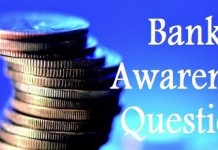Hello Aspirants,
Welcome to Banking Awareness Quiz in AffairsCloud.com. Here we are creating quiz covering important questions which are common for all the bank exams and other competitive exams.
- What does amortization mean?
A. Spreading payments over multiple periods
B. Buying a financial instrument in order to sell the same instrument at a higher price in another market
C. Issuance approval,by a credit card issuer
D. Buying the underlying securities at a specified excercise price
E. None of the AboveA. Spreading payments over multiple periods
Explanation:
Amortization is an accounting term that refers to the process of allocating the cost of an intangible asset over a period of time. It also refers to the repayment of loan principal over time. - What is the duration of Public Provident Fund (PPF) account?
A. 3 years
B. 5 years
C. 9 years
D. 15 years
E. 18 yearsD. 15 years
Explanation:
A PPF account matures in 15 years, but you can extend the tenure in blocks of five years after maturity. The balance continues to earn interest at the normal rate. The minimum investment of Rs 500 has to be maintained even for accounts extended beyond 15 years. - Under which Act are the KYC norms implemented?
A. SEBI Act 1992
B. Foreign Contribution and Regulation Act, 1976
C. Prevention of Money laundering Act 2002
D. Banking Regulation Act, 1949
E. Both (C) and (D)C. Prevention of Money laundering Act 2002
Explanation:
KYC guidelines/instructions are issued under under Prevention of Money laundering Act PMLA, 2002. - When a customer deposits cheque to a bank, the bank is a(n)
A. Drawer
B. Agent
C. Principal
D. Drawee
E. BaileeB. Agent
Explanation:
When a customer deposits cheque to a bank then that particular bank acts as an agent for the customer. Collection occurs when the drawee bank (the bank ordered by the cheques to make payment) takes funds from the account of the drawer (its customer who has written the cheque) and presents it to the collecting bank. - Which of the following is a receipt, declaring ownership of shares of a foreign company. which can be listed in India and traded in rupees?
A. ADR
B. GDR
C. IDR
D. EDR
E. None of the AboveC. IDR
Explanation:
An IDR(Indian Depository Receipts)is a receipt, declaring ownership of shares of a foreign company. These receipts can be listed in India and traded in rupees. - What is the term for a bank without any branch network that offers its services remotely?
A. Internet only Banks
B. Direct Bank
C. Lending Institution
D. Indirect Bank
E. Online BankB. Direct Bank
Explanation:
A direct bank is a bank without any branch network that offers its services remotely via online banking and telephone banking and may also provide access via ATMs (often through interbank network alliances), mail and mobile. By eliminating the costs associated with bank branches, direct banks can make significant savings which they may pass on to clients via higher interest rates or lower service charges. - Derivatives contract which gives the buyer/holder of the contract the right(but not the obligation) to buy/sell the underlying asset at a predetermined price within or at end of a specified period is known as
A. Futures contract
B. Option Contract
C. Index Futures contract
D. Mini Derivative contract
E. None of the AboveB. Option Contract
Explanation:
Options Contract is a type of Derivatives Contract which gives the buyer/holder of the contract the right (but not the obligation) to buy/sell the underlying asset at a predetermined price within or at end of a specified period. - For expanding access to banking services, the RBI has advised banks to open branches with minimum infrastructure support of 8 to 10BC units at a reasonable 3-4km. Such branches are known as _______
A. White Label ATMs
B. Ultra Small Branches
C. Banking Kiosks
D. CBS Terminals
E. ICT HubsB. Ultra Small Branches
Explanation:
Ultra Small Branches may be set up between the base branch and BC locations so as to provide support to about 8-10 BC Units at a reasonable distance of 3-4 kilometres. These could be either newly set up or by conversion of the BC outlets. Such Ultra Small Branches should have minimum infrastructure such as a Core Banking Solution (CBS) terminal linked to a pass book printer and a safe for cash retention for operating large customer transaction and would have to be managed full time by bank officers/ employees. - According to the Income Tax act of 1961, the age of Super senior Citizens should be _______
A. 60 years
B. 70 years
C. 80 years
D. 75 years
E. 65 yearsC. 80 years
Explanation:
According to the Income Tax act of 1961, the age of Super senior Citizens is 80 years. - Part of company’s earning or profit which is paid out to share holders is known as _______
A. Premium
B. Dividend
C. Bonus
D. Sum Assured
E. ReturnB. Dividend
Explanation:
A dividend is a payment made by a corporation to its shareholders, usually as a distribution of profits. When a corporation earns a profit or surplus, it can re-invest it in the business (called retained earnings), and pay a fraction of the profit as a dividend to shareholders.
AffairsCloud Recommends Oliveboard Mock Test
AffairsCloud Ebook - Support Us to Grow
Govt Jobs by Category
Bank Jobs Notification


